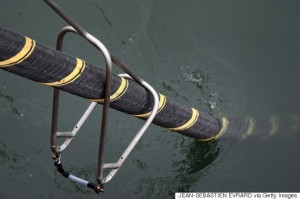In The Circle by David Eggers, Kalden takes Mae down one night to see “Stewart.” “Stewart” is a cube-like structure in which The Circle keeps all of the video information they have been recording. Mae seems kind of surprised in the book, but it is not at all surprising that The Circle has “Stewart.” If you think about it, The Circle would like to keep all of their data so that it can be accessed at any time, but that information just doesn’t go to some cloud in the sky. The Circle, like every other tech company or any person or entity, needs a place to store their data. Something physical. That is why The Circle has “Stewart.” Think of it almost as a much larger and complex version of a USB drive or a memory card. Now we may not have storage tech like “Stewart,” but we do have plenty of storage locations in the United States. Essentially, the United States and companies have huge facilities with servers that are used for the sole purpose of storing data. That is what The Circle is doing, but with a more advanced type of server than we currently see today.
What other technology do we have that often gets forgotten about? That is where Nicole Starosielski’s “Undersea Cable Network Operates in a State of Alarm” comes into play. How do you think that most of the internet’s data is sent across continents and around the globe? Magic? That would be wrong. Satellites? That would also be wrong. Undersea cables? Correct! You probably got that from the title, didn’t you? Most of the data that we transit around the globe is sent through cables. How many of you have DSL or fiber optic? Those are cables sending and receiving data every time you use the internet. So of course it would only make sense that undersea cables are the most used method to send data around the globe.
Now you’re probably wondering: “What’s the article say about undersea cables?” Well, in the article; which is an excerpt from a larger work; Nicole Starosielski visited the network operations centers where the undersea cables are monitored by engineers. Dr. Starosielski described the center as “a room dominated by computer screens, endless information feeds of network activity, and men carefully monitoring the links that carry Internet traffic in and out of the country.” These men don’t just monitor though. When something happens an alarm goes off that signals a problem, and then these engineers get to the real work. In order to maintain the flow of data constant, these men have to find why the alarm is going off and then solve the problem. Sometimes the problem is simple, like a loose cable, and sometimes the problem might be larger, like a cable break. The system is very complex and requires the best and most reliably engineers, yet this is a job that nobody seems to know about. Like most Americans, I didn’t even know how complex the system was before reading the article. One engineer stated, “Nobody goes to school and says I want to be in the undersea cable business.” There is no direct path to this career and few people even know about it, but these cables are extremely valuable to our way of life. What do you think would be the outcome if the undersea cable system failed?
Undersea cables are one of the objects that we take for granted and yet know nothing about. There are so many technologies and objects that help us in our lives that we seem to underappreciate. How about our indoor plumbing system, satellite broadcasting, calculators, or clocks? Have you ever thought about the complexity of calculators? I have, it’s kind of mind-blowing. Thinking about how far technology has come can be mind-blowing and yet we seem to know next to little or nothing about the objects we use on a daily basis. So I urge you to think about some objects and technologies that you use every day and think about the system that is involved with it. You may find yourself surprised. I think that appreciating how these things benefit our lives and how they work is important. Now, I think I need to take my own advice and go read up on satellites!

Undersea cables I think are the least of our issues if we discuss upgrading the world’s infrastructure. Many of the United State’s own connections still rely on aging telephone lines as well as aging TeleCom laws. Google is currently working on a project that would send permanent balloons into the air that blanket the world in a free wifi, to promote global connectivity.
Wires still offer better upload and download speeds because they can do both at the same time. With wifi, the signal can only upload or download. The signals can’t do both. You’ll need to figure out how to improve that (even if it can be improved) before I decide to completely move to wireless.